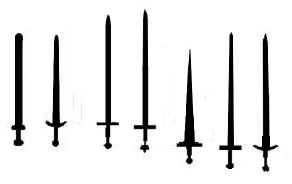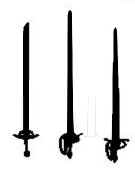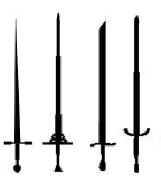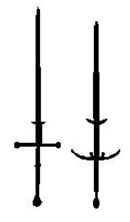Medieval & Renaissance Sword Forms and Companion Implements
Medieval Swords
Medieval swords existed in great varieties over a number of centuries. Both experimentation and specialization in design was constant. But certain common characteristics can describe the "generic" medieval sword as a long, wide, straight, double-edged blade with a simple cross-guard (or "cruciform" hilt). It might be designed for one or two-hands. The typical form was a single hand weapon used for hacking, shearing cuts and also for limited thrusting. This style developed essentially from Celtic, Germanic, Anglo-Saxon, and late Roman (the spatha) forms.

The Viking and early Frankish forms (the "spata") are also considered to be more direct ancestors. Medieval swords can be classified (typically by hilt design) into a great many categories by curators, collectors, and military historians. However, students & re-creationists today should prefer the actual historical terms. At the time, long bladed weapons were simply referred to as "swords", or for the longer ones often a "sword of war", "war-sword" (French Espée du Guerre or Epee du Guerre), or even a "long-sword". Various languages might call them by schwert, svard, suerd, swerd, espada, esapadon, or epee. When later worn on the belt by mounted knights they might be called an Arming-sword. Arming-swords were also considered "riding-swords" (also parva ensis or epee courte). It is this single-hand form which is so closely associated with the idea of the "knightly sword" (c. 1300). The challenge of armor in the Age-of-plate, forced many blades (both single-hand and longer) to be made narrower and pointier, but also thicker and more rigid. Ffrom at least the late 1300’s in England, a single-hand blade of this form was referred as a "short swerde". In 15th century Germany it was the Kurczen swert. At this same time, as a result of the increased use of thrusting techniques some blades adopted guards with knuckle-bars, finger-rings, and/or sides-rings which lead to the compound-hilt. In later Elizabethan times, older one-handed medieval type blades became known as "short-swords" while the larger variety were still referred to as "long-swords". The term "short sword" was used later by 19th century collectors to refer to any style of "shorter" one-handed swords typically from ancient times on.
The Broadsword
A term popularly misapplied as a generic synonym for medieval swords or any long, wide military blade. The now popular misnomer "broadsword" in reference to Medieval blades actually originated with collectors in the early 19th century -although many mistranslations and misinterpretations of Medieval literature during the 19th & 20th centuries have inserted the word broadsword in place of other terms.

They described swords of earlier ages as being "broader" than their own contemporary thinner ones. Many 17th-19th century blades such as spadroons, cutlasses, and straight sabers are classed as broadswords as are other closed hilt military swords. The weapon known as the true broadsword is in fact a form of short cutlass. The term "broadsword" does not appear in English military texts from the 1570s - 1630s and noes not show up in inventories of sword types from the 1630's, and likely came into use sometime between 1619 and 1630. Descriptions of swords as "broad" before this time are only incidental and the word "broad" is used as an adjective in the same way "sharp" or "large" would be applied. Leading arms curators almost always list the broadsword specifically as a close-hilted military sword from the second half of the 17th century. Those cage and basket hilted blades used by cavalry starting in the 1640's were in form, "broadswords". During this time a gentleman's blade had become the slender small-sword, whereas the military used various cutting blades. Today, arms collectors, museum curators theatrical-fighters, and fantasy-gamers have made the word broadsword a common, albeit blatantly historically incorrect, term for the Medieval sword.
Long-Swords
The various kinds of long bladed Medieval swords that had handles long enough to be used in two hands were deemed long-swords (German Langenschwert/ Langes Swert or Italian spada longa). Long-swords, war-swords, or great swords are characterized by having both a long grip and a long blade.

We know at the time that Medieval warriors did distinguished war-swords or great-swords ("grant espees" or "grete swerdes") from "standard" swords in general, but long-swords were really just those larger versions of typical one-handed swords, except with stouter blades. They were "longer swords", as opposed to single-hand swords, or just "swords". They could be used on foot or mounted and sometimes even with a shield. The term war-sword from the 1300's referred to larger swords that were carried in battle. They were usually kept on the saddle as opposed to worn on the belt. A 15th century Burgundian manual refers to both "great and small swords". As a convenient classification, long-swords include great-swords, bastard-swords, and estocs. In the 1200’s in England blunt swords for non-lethal tournaments were sometimes known as "arms of courtesy". There is a reference to an English tournament of 1507 in which among the events contestants are challenged to "8 strookes with Swords rebated". Wooden training weapons were sometimes called wasters in the 1200's or batons in the 1300's and 1400's. Knightly combat with blunt or "foyled" weapons for pleasure was known as à plaisance, combat to the death was à lóuutrance.
Great-Swords
Those blades long and weighty enough to demand a double grip are great-swords. They are infantry swords which cannot be used in a single-hand. Originally the term "great-sword" (gret sord, grete swerde, or grant espée), only meant a war-sword (long-sword), but it has now more or less come to mean a sub-class of those larger long-swords/war-swords that are still not true two-handers.

They were even known as Grete Swerdes of Warre or Grans Espees de Guerre. Although they are "two hand" swords, great-swords not are the specialized weapons of later two-handed swords. They are the swords that are antecedents to the even larger Renaissance versions. Great-swords are also the weapons often depicted in various German sword manuals. A Medieval great-sword might also be called a "twahandswerds" or "too honde swerd". Whereas other long-swords could be used on horseback and some even with shields, great swords however were infantry weapons only. Their blades might be flat and wide or later on, more narrow and hexagonal or diamond shaped. These larger swords capable of facing heavier weapons such as pole-arms and larger axes were devastating against lighter armors. Long, two-handed swords with narrower, flat hexagonal blades and thinner tips (such as the Italian "spadone") were a response to plate-armor. Against plate armor such rigid, narrow, and sharply pointed swords are not used in the same chop and cleave manner as with flatter, wider long-swords and great swords. Instead, they are handled with tighter movements that emphasize their thrusting points and allow for greater use of the hilt. Those of the earlier parallel-edged shape are known more as war-swords, while later the thicker, tapering, sharply pointed form were more often called bastard-swords. One type of long German sword, the "Rhenish Langenschwert", from the Rhenish city of Cologne, had a blade of some 4 feet and an enormous grip of some 14 to 16 inches long, not including the pommel.
Bastard Swords
In the early 1400's (as early as 1418) a form of long-sword often with specially shaped grips for one or two hands, became known as an Espée Bastarde or "bastard sword". The term may derive not form the blade length, but because bastard-swords typically had longer handles with special "half-grips" which could be used by either one or both hands. In this sense they were neither a one-handed sword nor a true great-sword/two-handed sword, and thus not a member of either "family" of sword. Evidence shows the their blade were typically tapered. Since newer types of shorter swords were coming into use, the term "bastard-sword" came to distinguish this form of long-sword. Bastard-swords typically had longer handles with special "half-grips" which could be used by either one or both hands. These handles have recognizable "waist" and "bottle" shapes (such grips were later used on the Renaissance two-handed sword). The unique bastard-sword half-grip was a versatile and practical innovation. Although, once again classification is not clear since the term "bastard-sword" appears to have not been entirely exclusive to those swords with so-called "hand-and-a-half" handles as older styles of long-sword were still in limited use. Bastard-swords varied and they might have either a flat blade or narrow hexagonal one for fighting plate-armor. Some were intended more for cutting while others were better for thrusting. Bastard swords continued to be used by knights and men-at-arms into the 1500's. Their hilt style leads toward the shorter cut & thrust sword forms of the Renaissance. Strangely, in the early Renaissance the term bastard-sword was also sometimes used to refer to single-hand arming-swords with compound-hilts. A form of German arming sword with a bastard-style compound hilt was called a "Reitschwert" ("cavalry sword") or a "Degen" ("knight's sword"). Although these might have been forms of single-hand estoc.

The familiar modern term "hand-and-a-half" was more or less coined to describe bastards swords specifically.The term "hand-and-a-half sword" is often used in reference to long-swords is not historical and is sometimes misapplied to other swords (although during the late 1500's, long after such blades fell out of favor, some German forms of this phrase are believed to have been used). While there is no evidence of the term “hand-and-a-half” having been used during the Middle Ages, either in English or other languages, it does appear in the 16th century. In his 1904 bibliography of Spanish texts, D. Enrique de Leguina gives a 1564 reference to una espada estoque de mano y media, and a 1594 reference to una espada de mano y media. In the Ragionamento, the unpublished appendix to his 1580, Traite d Escrime (“Fencing Treatise”), Giovanni Antonio Lovino describes one sword as una spada di una mano et mana et meza (literally “hand and a half sword”) which he distinguishes from the much larger spada da due mani or two-handed sword (the immense Renaissance weapon). The term spadone was used by Fiore Dei Liberi in 1410 to refer to a tapering long-sword and Camillo Agrippa in 1550 called the spadone a war sword. Later it was defined by John Florio in his 1598 Italian-English dictionary as “a long or two-hand sword”.
Two-handed Swords
The term "two-hander" or "two-handed sword" (espée a deure mains or spada da due mani) was in use as early as 1400 and is really a classification of sword applied both to Medieval great-swords as well Renaissance swords (the true two-handed swords).

Such weapons saw more use in the later Middle Ages and early Renaissance. Technically, true two-handed swords (epee's a deux main) were actually Renaissance, not Medieval weapons. They are really those specialized forms of the later 1500-1600's, such as the Swiss/German Dopplehander ("double-hander") or Bidenhander ("both-hander") or Zweihander / Zweyhander are relatively modern not historical terms. English ones were sometimes referred to as "slaughterswords" after the German Schlachterschwerter ("battle swords"). These weapons were used primarily for fighting against pike-squares where they would hack paths through lobbing the tips off the poles. In Germany, England, and elsewhere schools also taught their use for single-combat. In True two-handed swords have compound-hilts with side-rings and enlarged cross-guards of up to 12 inches. Most have small, pointed lugs or flanges protruding from their blades 4-8 inches below their guard. These parrierhaken or "parrying hooks" act almost as a secondary guard for the ricasso to prevent other weapons from sliding down into the hands. They make up for the weapon's slowness on the defence and can allow another blade to be momentarily trapped or bound up. They can also be used to strike with. The most well-known of "twa handit swordis" is the Scottish Claymore (Gaelic for "claidheamh-more" or great-sword) which developed out of earlier Scottish great-swords with which they are often compared. They were used by the Scottish Highlanders against the English in the 1500's. Another sword of the same name is the later Scots basket-hilt broadsword (a relative of the Renaissance Slavic-Italian schiavona) whose hilt completely enclosed the hand in a cage-like guard. Both swords have come to be known by the same name since the late 1700's. Certain wave or flame-bladed two-handed swords have come to be known by collectors as flamberges, although this is inaccurate. Such swords developed in the early-to-mid 1500's and are more appropriately known as flammards or flambards (the German Flammenschwert). The flamberge was also a term later applied to certain types of rapiers. The wave-blade form is visually striking but really no more effective in its cutting than a straight one. There were also huge two-handed blades known as "bearing-swords" or "parade-swords" (Paratschwert), weighing up to 12 or even 15 pounds and which were intended only for carrying in ceremonial processions and parades. In the 1500’s there were also a few rare single-edged two-handers such as the Swiss-German Grosse Messer or later sometimes called a Zwiehand sabel.
thearma.org

0 Comments:
Post a Comment
Subscribe to Post Comments [Atom]
<< Home